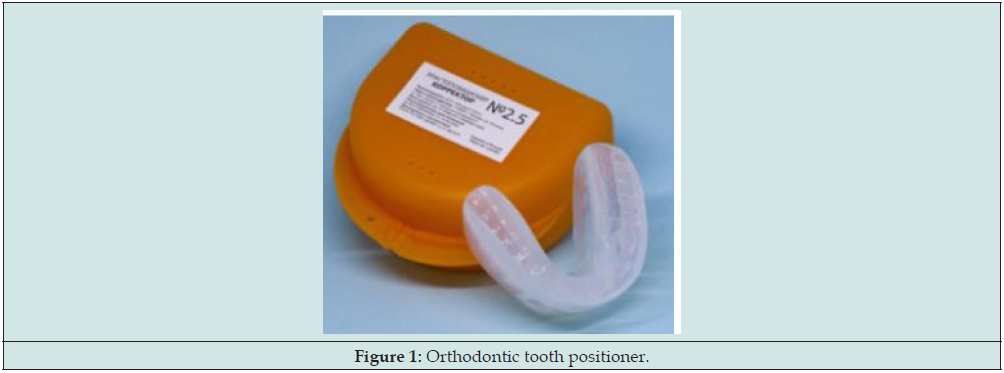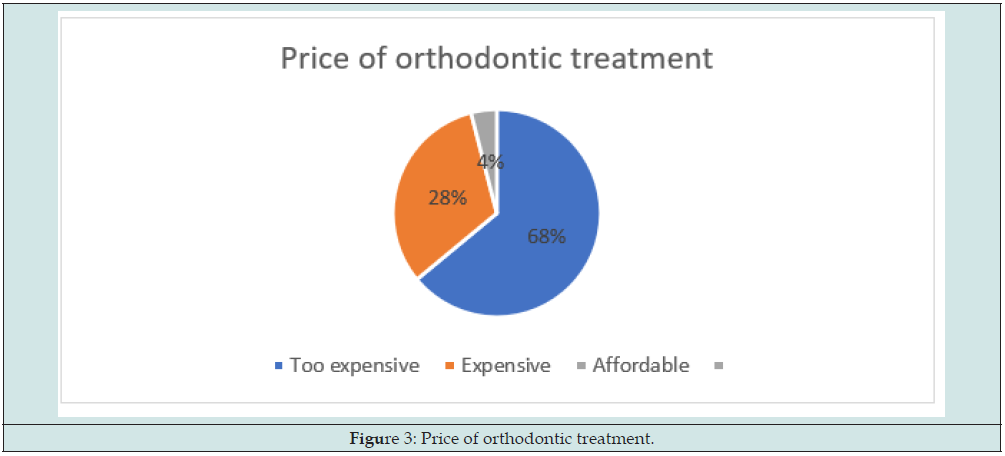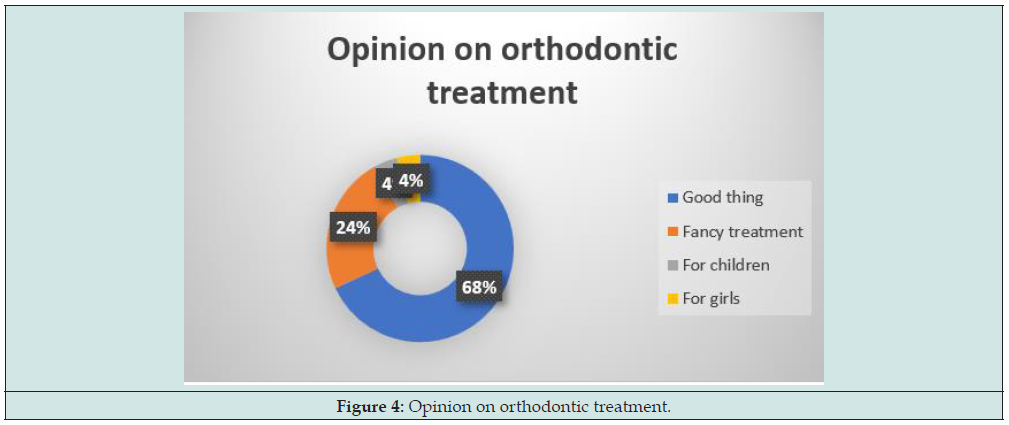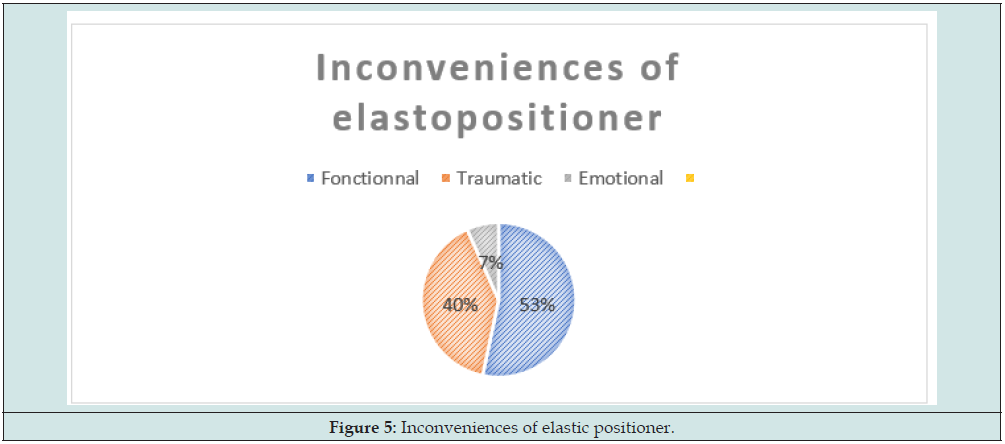
Lupine Publishers Group
Lupine Publishers
Menu
ISSN: 2637-4692
Research Article(ISSN: 2637-4692) 
Perception of Cameroonian Parents about Orthodontic Tooth Positioner Volume 5 - Issue 4
Kamgang Nzeugang Wilfrid1,2,4*, Kosyreva Tamara Fedorovna4, Nokam Kamdem Gimel Stephane1,3, Zilefac Brian Ngokwe1,3, Tchuala Moukam Laetitia1 and Rasha Almasri4
- 1Department of Oral surgery, Maxillofacial surgery and Periodontology, Faculty of Medicine and Biomedical Sciences; University of Yaoundé I, Cameroon
- 2Yaounde Central Hospital, Cameroon
- 3Post graduate school for Life, Health, and Environmental Sciences, University of Yaoundé I, Cameroon
- 4People’s friendship University of Russia (RUDN University) Moscow, Russia
Received: August 9, 2022; Published: August 16, 2022
Corresponding author: Kamgang Nzeugang Wilfrid, Department of Oral surgery, Maxillofacial surgery and Periodontology, Faculty of Medicine and Biomedical Sciences; University of Yaoundé I, Cameroon
DOI: 10.32474/MADOHC.2022.05.000216
Summary
Background/Objectives: A healthy mouth, teeth and gums, is an important part of good overall health. One of the pathologies affecting the oral cavity is dental malocclusions. Due to a lack or unequal distribution of oral health professionals amongst other reasons, most patients having malocclusions in Cameroon remain untreated. Orthodontic tooth positioner are orthodontic appliances formed as an arch-shaped body fitting within a patient’s mouth between the upper and lower arches. Since this appliance is relatively new in our context, we conducted a descriptive study in order to access the perception of Cameroonian parents towards orthodontic tooth positioner.
Materials/Methods: We carried out a descriptive qualitative study involving one-to-one, semi-structured, in-depth interviews with parents/guardians of patients who were undergoing orthodontic treatment in the 2 main cities: Douala and Yaoundé.
Results: There were 90 parent participants in this study, 47 mothers and 43 fathers. The mean age of the parents was 41.3±8.3 years old. The age range of their kids varied from 6 to 13 years old. A great majority of parents (96%) had never experienced an orthodontic treatment, 80% of parents were unhappy with the teeth position of their kids, 68% of patients were convinced that orthodontics is something good, 4% found the treatment affordable and 64% of parents reported that their kids do not always wear the orthodontic tooth positioner.
Conclusion: Information on the perception of orthodontic treatment can be used to influence decision making on the orthodontic services to be provided, human resource training needs, continuing education for oral health personnel and resource planning.
Keywords: Orthodontic Tooth Positioner; Dental Malocclusions; Perception
Introduction
A healthy mouth, teeth and gums, or oral health, is an important part of good overall health, well-being and quality of life. WHO defines oral health as “a state of being free from chronic mouth and facial pain, oral and throat cancer, oral infection and sores, periodontal (gum) disease, tooth decay, tooth loss, and other diseases and disorders that limit an individual’s capacity in biting, chewing, smiling, speaking, and psychosocial well-being ”[1]. An example of these pathologies includes dental malocclusions. It is defined as a misalignment or incorrect relation between the teeth of the upper and lower dental arches when they approach each other as the jaws close. Crowded teeth, crossbite, overbite, underbite, and open bite are all considered as malocclusion [2]. Due to a lack or unequal distribution of oral health professionals, a lack of appropriate facilities, in Cameroon - no dedicated oral health budget, people incur significant out-of-pocket expenses to access orthodontic treatment, while most patients having malocclusions in Cameroon remain untreated [1].
To overcome these problems, orthodontic tooth positioner (OTP) will be increasingly used in Cameroon (Figure 1). They are orthodontic appliances formed as an arch shaped body of a (Silastic) resilient material fitting within a patient’s mouth between the upper and lower arches [3]. They are generally having a concave surface for bearing on the buccal and labial surfaces of the teeth of at least one arch and a convex surface adjacent to the lingual surface of the patient’s teeth. They are easy to fabricate, inexpensive, aesthetic, and comfortable, and thus have a high level of patient acceptance [4]. Clear thermoplastic appliances have been recommended for use as transitional retainers, finishing appliances [5-7] and even permanent retention [6,7]. Since this appliance is relatively new in our context, we conducted a descriptive study in order to access the perception of Cameroonian parents towards OTP.
Materials and Methods
Research approval and ethical clearance were obtained from the Institutional Committee for Ethics and Research of the Faculty of Medicine and Biomedical Sciences prior to commencing study recruitment. All participants completed written consent (Figure 2). As described in the introduction, this was a descriptive qualitative study involving one-to-one, semi-structured, in-depth interviews with parents/guardians of patients who were undergoing orthodontic treatment in Douala and Yaoundé. Parents were included in the study if they had a child aged 6-13 years (inclusive) who had an orthodontic tooth positioner. All of the patients were eligible for treatment, based on the Index of Orthodontic Treatment Need. Parents of children with craniofacial syndromes, malocclusions due to trauma or pathology, and those with significant restorative implications were excluded. Participants were selected using a voluntary response sampling technique based on age, gender, and ethnicity of the patient; the patient’s malocclusion; orthodontic history and knowledge of parents, orthodontic treatment need, attitude towards orthodontic appliance and attitude of the child during the treatment. This technique ensured that participants were selected to represent key characteristics of interest to the study and enhanced the generalizability of the results, while acknowledging there is debate surrounding generalizability of qualitative data. All interviews were done using a questionnaire undertaken by two members of the research team in a private area away from the clinic. The interviews followed a topic guide, which was developed specifically for this study and was updated as new topics arose during the interviews. In keeping with qualitative methodology, no sample size calculation and no statistical testing were undertaken. Interviews were conducted until no new themes were arising, a point at which ‘theoretical saturation’ is sometimes said to have been achieved. It is important to note that qualitative samples are frequently small in size and this does not detract from the quality of the data obtained, an opinion needs to appear only once for it to be an important finding. Interviews were digitally recorded and transcribed verbatim immediately afterwards. Data were then analyzed using a content thematic analysis using a framework approach and were undertaken by all three researchers to ensure consistency. Major themes and subthemes were identified and this classification was agreed by all members of the research team.
Results
There were 90 parent participants in this study, 47 mothers and 43 fathers. The mean age of the parents was 41.3±8.3 years old. 80% of parents work in the private sector. Moreover 95% of parents a university level of education. 92% of parents were married. Half of the parents were semi-bantus. The age range of their kids varied from 6 to 13 years old. The patients had a variety of malocclusions, with all skeletal classifications represented. The majority of parents in this study were interviewed at least 5 months after their child started wearing the appliances. The interviews lasted up to 30 minutes in duration. Four main themes were investigated in our study: orthodontic history and knowledge of parents, orthodontic treatment need, attitude towards orthodontic appliance and attitude of the child during the treatment.
Orthodontic history and knowledge of parents
A great majority of parents (96%) had never experienced an orthodontic treatment, though 68% of parents knew at least one person who had experienced orthodontic treatment. Only 32% of parents were satisfied with their teeth position. Dentist (52%) and family members (24%) were the main persons to inform parents about orthodontic treatment.
Orthodontic treatment need
80% of parents were unhappy with the teeth position of their kids (prior to treatment). 88% of parents agreed on the necessity of having well aligned teeth essentially to have a good smile (32%) and aesthetic appearance (36%)
Attitude toward orthodontic appliance
68% of patients were convinced that orthodontics is something good. A great majority of the participant (68%) said that orthodontic treatment is very expensive. 52% of patients are convinced that the orthodontic tooth positioner is a very good. 80% are convinced that there is an amelioration of the malocclusion moreover 60% of participants think that the amelioration is slow (Figures 3 & 4).
Attitude of the child during the treatment
64% of parents reported that their kids do not always wear the orthodontic tooth positioner. 68% of parent found that the appliance causes some discomfort (speech 16% and mucosal wounds 12%) (Figure 5).
Discussion
The analysis used in this study was a thematic framework which resulted in four different themes. In keeping with qualitative methodology, no sample size calculation and no statistical testing were undertaken. The fact that this study highlights the perceived view of parents on orthodontic treatment using orthodontic tooth positioners helps to demystify the myth in our context given that our study is pioneer in Central Africa to the best of our knowledge. Some studies have reported that perceptions of malocclusion do not differ among various racial groups and cultural circumstances [8-12] but African people living in Africa can have different malocclusion perceptions compared with other societies. For example, median diastema is significantly disliked in white cultures, [12-14] but it is considered desirable and a sign of beauty in many African cultures [12]. 50/90(56%) of parents were satisfied with their alignment but only 4/90(4%) had received an orthodontic treatment this could be due to the fact of their ignorance on this treatment and its relative unavailability in our context.70/90(88%) parents think it is necessary to have a good tooth alignment this could because individuals do make judgments about social and intellectual ability based on facial appearance and attractiveness, including the appearance of the mouth and teeth [15] There is also a research that shows that attractive children are judged and subsequently treated more positively than less attractive children. And this can be comforted by the fact that 40.9% of these parents think the good tooth alignment is necessary for aesthetic reasons [15]. 68% of parents found the treatment too expensive and we think this could be due to the load of the treatment on the individuals. And the absence of a national health coverage in our context. Public resources allocated to the health sector in Cameroon remain one of the lowest in Africa in terms of Gross Domestic Product (GDP) [16-18] To show the financial burden shouldered by the local population, in 2010, the government contributed only 28% (US$17) with US$8 of that amount provided by international donors out of the US$61 per Cameroonian [15,18]. In 2015, out of US$156 per person spent on health in the country, US$108 was out-of-pocket spending, US$23 was government health spending, US$20 was development assistance for health and US$5 was prepaid private spending. [17,18] Hence, the cost of healthcare is largely borne by individuals through out-of-pocket payments [18]. This could explain why we have only four (4%) of parents found the treatment affordable. Fifty-two (52%) of parents were informed of orthodontic treatment by dental physicians showing the lack of knowledge of the population on this therapeutic option and showing the increased need for sensitization to the general population. Clear thermoplastic appliances are aesthetic and comfortable and thus patient cooperation is better than with other retainers [7,19] Maintenance of the appliance is tedious for the patient [4]. This can be seen in our study as 64% of parents reported that their kids do not always wear the orthodontic tooth positioner. 68% of parent found that the appliance caused some discomfort (speech 16% and mucosal wounds 12%). This could be due to the fact that as the tooth position settles and adjusts in the mouth, sore spots might occur in the gums [4]. The OTP also aids in developing lip competence and facial muscle tone [20].
Conclusion
Parents in this study reported their views of their children orthodontic treatment. Information on the perception of orthodontic treatment can be used to influence decision making on the orthodontic services to be provided, human resource training needs, the design of treatment facilities, continuing education for oral health personnel, public health programs, screening for treatment, and resource planning. This information can also be used for patient education and information.
Conflict of Interest
None.
Statement of Informed Consent
Informed consent was obtained before initiating the study from all participants.
References
- Oral Health WHO Regional Office for Africa.
- Oxford English Dictionary. Online. Oxford University Press, USA.
- Rinchuse DJ, Sassouni V (1983) An evaluation of functional occlusal interferences in orthodontically treated and untreated subjects. Angle Orthod 53(2): 122-130.
- Pravindevaprasad A, Therese BA (2103) Tooth positioners and their effects on treatment outcome. J Nat Sci Biol Med 4(2): 298-301.
- McNamara JA, Kramer KL, Juenker JP (1985) Invisible retainers. J Clin Orthod 19(8): 570-578.
- Sheridan JJ, LeDoux W, McMinn R (1993) Essix retainers: fabrication and supervision for permanent retention. J Clin Orthod 27(1): 37-45.
- Dinçer M, Isik Aslan B (2010) Effects of thermoplastic retainers on occlusal contacts. Eur J Orthod 32(1): 6-10.
- Tedesco LA, Cunat JJ, Lewis EA, Slaker MJ (1983) A dentofacial attractiveness scale. Am J Orthod 83(1): 38-43.
- Kiyak HA (1981) Comparison of esthetic values among Caucasians and Pacific Asians. Community Dent Oral Epidemiol 9(5): 219-223.
- Cons NC, Jenny J, Kohout FJ, Freer TJ, Eismann D (1983) Perceptions of occlusal conditions in Australia, the German Democratic Republic and the United States of America. Int Dent J 33(2): 200-206.
- Tulloch JFC, Shaw WC, Smith A (1984) A comparison of attitudes towards orthodontic treatment in British and American communities. Am J Orthod 85(3): 253-259.
- Article O Perceptions of dental attractiveness and orthodontic treatment need among Tanzanian children pp. 16-18.
- Helm S, Petersen PE, Kreiborg S, Solow B (1986) Effect of separate malocclusion traits on concern for dental appearance. Community Dent Oral Epidemiol 14(4): 217-220.
- Kerosuo H, Hausen H, Laine T, Shaw WC (1995) The influence of incisal malocclusion on the social attractiveness of young adults in Finland. Eur J Orthod 17(6): 505-512.
- Shah R, Alquraini N, Cunningham SJ (2019) Parents’ perceptions of outcomes of orthodontic treatment in adolescent patients: a qualitative study. Eur J Orthod 41(3): 301-307.
- (2013) World Bank Cameroon Economic Update. Towards Greater Equity, World Bank, Washington, DC, USA.
- (2017) Institute for Health Metrics and Evaluation. Financing Global Health, Institute for Health Metrics and Evaluation, Seattle, WA, USA.
- Ojong N (2019) Healthcare Financing in Rural Cameroon pp. 1-12.
- Sheridan JJ, Gaylord RE, Hamula W, Hickham JH, Kokich VG, et al. (1992) JCO Roundtable: finishing and retention. Journal of Clinical Orthodontics 26: 551-564.
- Park Y, Hartsfield JK, Katona TR, Eugene Roberts W (2008) Tooth positioner effects on occlusal contacts and treatment outcomes. Angle Orthod 78(6): 1050-1056.490490

Top Editors
-

Mark E Smith
Bio chemistry
University of Texas Medical Branch, USA -

Lawrence A Presley
Department of Criminal Justice
Liberty University, USA -

Thomas W Miller
Department of Psychiatry
University of Kentucky, USA -

Gjumrakch Aliev
Department of Medicine
Gally International Biomedical Research & Consulting LLC, USA -

Christopher Bryant
Department of Urbanisation and Agricultural
Montreal university, USA -

Robert William Frare
Oral & Maxillofacial Pathology
New York University, USA -

Rudolph Modesto Navari
Gastroenterology and Hepatology
University of Alabama, UK -

Andrew Hague
Department of Medicine
Universities of Bradford, UK -

George Gregory Buttigieg
Maltese College of Obstetrics and Gynaecology, Europe -

Chen-Hsiung Yeh
Oncology
Circulogene Theranostics, England -
.png)
Emilio Bucio-Carrillo
Radiation Chemistry
National University of Mexico, USA -
.jpg)
Casey J Grenier
Analytical Chemistry
Wentworth Institute of Technology, USA -
Hany Atalah
Minimally Invasive Surgery
Mercer University school of Medicine, USA -

Abu-Hussein Muhamad
Pediatric Dentistry
University of Athens , Greece

The annual scholar awards from Lupine Publishers honor a selected number Read More...









